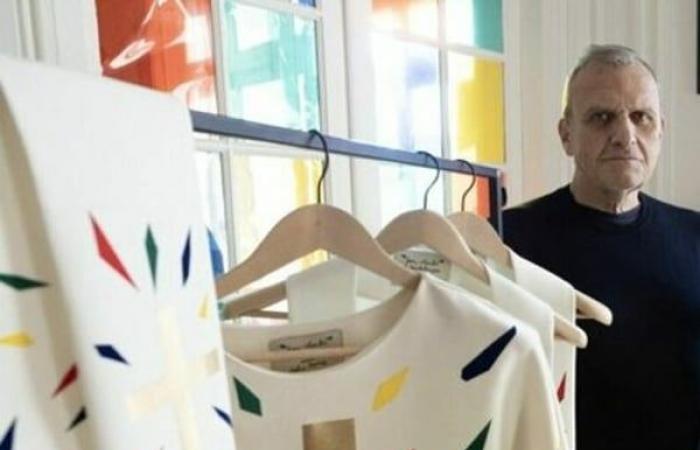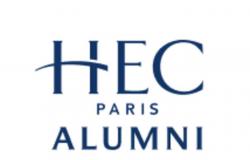Par
AFP
Published on
November 24, 2024
Bursts of red, blue, green and yellow velvet springing from a large gold cross flocked on a humble ecru wool gabardine: the artist Jean-Charles de Castelbajac unveiled to AFP on Friday the new liturgical outfits of Notre-Dame de Paris.
The light reflects on a door that looks like stained glass, in a Parisian apartment in the 17th arrondissement cluttered with colorful objects. It is here, among others, that “JCC”, 74 years old, designed the paramentics (liturgical vestments and ornaments) which will accompany the celebrations of the reopening of the cathedral, on December 7 and 8, five years after the fire which devastated her.
“It wasn't about making luxury clothes, it was about talking about 'lux' (light in Latin, Editor's note),” explains the stylist, pointing to a refined design, far from the traditionally busy and richly embroidered finery. of Catholic worship.
The jack-of-all-trades artist, a practicing Christian, known for his sweet-faced angels, found that his lineage “had become too pretty, too ornamental”. “We decided, with the diocese, that there would be no drawing and that I would do extremely simple work” with ornaments “which create proximity”, which speak to children, believers and atheists alike, summarizes- he.
He cites a vivid memory as a 17-year-old provincial: that of a dress from the Notre-Dame treasure that belonged to Saint-Louis. “It was a cruciform thing, extremely simple,” he describes with emotion, “which inspired my whole life as a designer.” He confides “the achievement” that its inscription represents for him, “with humility”, in the long history of the cathedral, “like a companion”.
– “People's Range” –
Meticulously, JCC caresses and unfolds the drapes of the chasubles, “chivalrous” for this history buff, flocked like sweatshirts to embrace modernity. For a year and a half, he collaborated with the best French luxury craft houses (Lesage, Goossens, Paloma, Montex, Maison Michel…), grouped together in the 19M workshops in Paris, to achieve a simple symbolism but dynamic and powerful.
Sitting on a large table, Jean-Charles de Castelbajac grabs his pair of scissors and intuitively cuts out sheets of red, green, blue, yellow paper – his favorite, “universal” colors, his “people's range”. He arranges the small scraps of paper around a cross and comments on his sketches: deacons' outfits with a grid of gold, red and blue, “medieval Mondrian”, banners, archbishops' chasubles and miters with the large cross of gold…
“I built my liturgical vestments around this radiant cross, which spreads joy, hope, living together through the multiplicity of these colors,” he continues with fervor. “Since the beginning of my career, I have kidnapped the rainbow,” he smiles, narrowing his sky blue eyes. “I was comforted by the color that was on the flags, on the stained glass windows, every morning in my college.” “It is something that I share intimately with the Church,” he continues, an institution with which he has collaborated twice, notably dressing John Paul II for World Youth Day (WYD) in 1997. In the red, he sees the blood of Christ, blue is that of Mary, green synonymous with hope, yellow is gold, “synthesis of everything”.
– “Dystopian era”, “driving” faith –
This wordless language of colors and their arrangement must “give hope and strength”, hence the epic dimension of these fragmentary explosions, to “make young people want to continue” in an “age of dystopia”, according to him.
Is the Church in danger? Rather “spirituality”, corrects the artist. “The younger generations are captivated by the society of spectacle, by images,” regrets JCC, for whom “the inner journey is being eluded.”
In the Notre-Dame fire on April 15, 2019, he saw, with “terrible emotion”, “like a premonition signal to a world in difficulty”. But for this “tireless optimist”, this fire was also “that of hope”. On returning home, he designed the roof of Notre-Dame in stained glass, installing rainbows and angels. “The fight is in each of us”, insists Jean-Charles de Castelbajac, passionately defending his “kind art”, his “compassionate art”. “Not trendy at all.” “It's almost more 'rock n' roll' today to work for the Church than to be with the Sex Pistols on the Thames in 77,” he slips mischievously.
By Clara GUILLARD
Paris, November 22, 2024 (AFP)
All reproduction and representation rights reserved.
© 2024 Agence France-Presse
All information reproduced in this section (or on this page as the case may be) is protected by intellectual property rights held by AFP. Consequently, none of this information may be reproduced, modified, rebroadcast, translated, commercially exploited or reused in any way without the prior written consent of AFP. AFP cannot be held responsible for delays, errors, omissions which cannot be excluded, nor for the consequences of actions or transactions carried out on the basis of this information.






